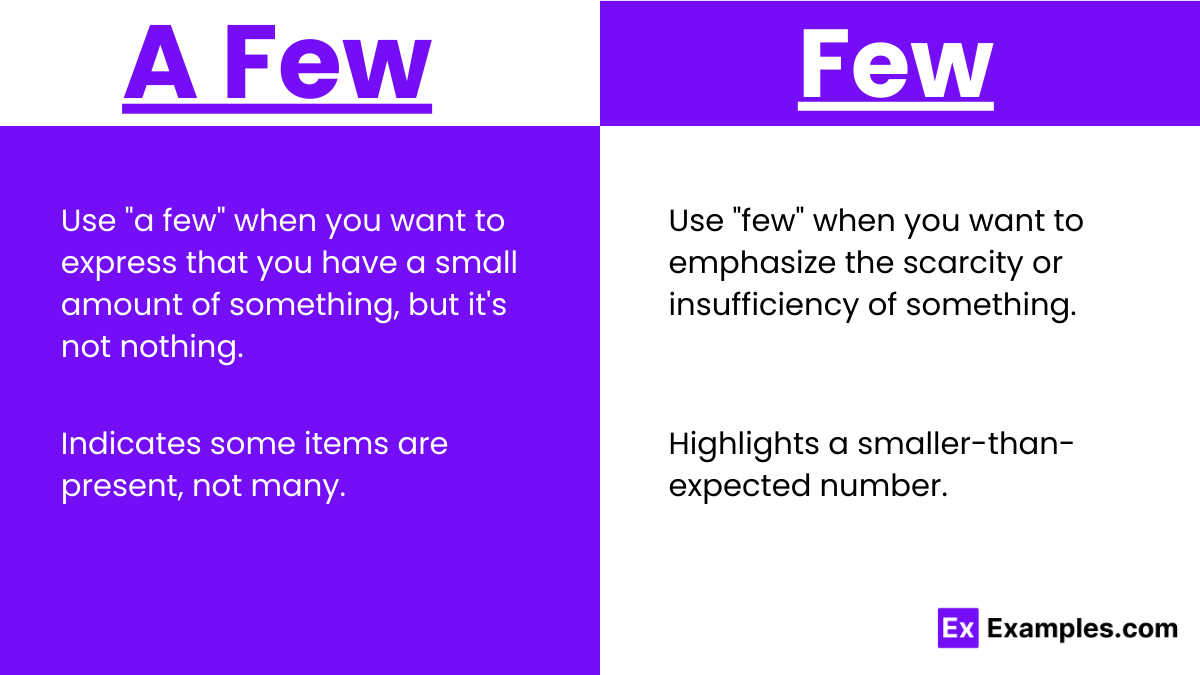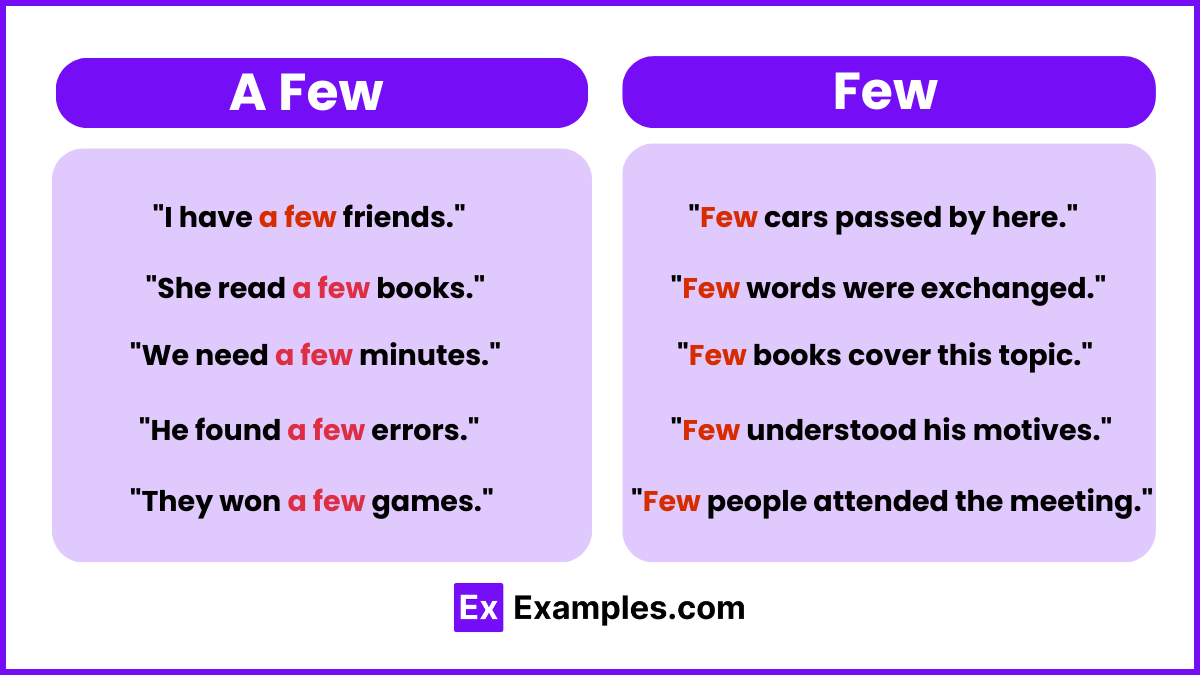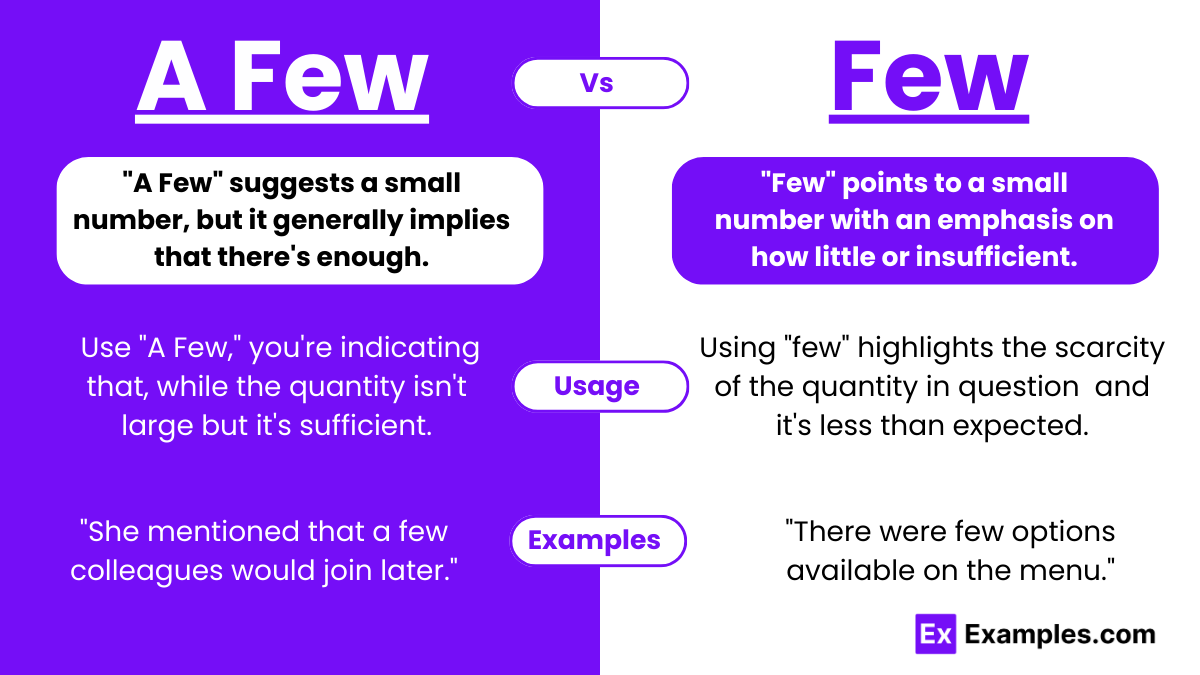A Few vs Few – Difference, Meanings, Examples, Usage
In simple terms, when we talk about “a few” and “few“, we’re looking at a small change that makes a big difference in meaning. “A few” is like giving a thumbs up, signaling that, although it’s not a lot, it’s enough or more than we might have expected. On the flip side, when we say “few“, it’s more like a thumbs down, suggesting that there’s not as much as we hoped for or needed. . Let’s clear these distinctions together, making it easier to grasp and apply these expressions in your daily dialogues and writings.
A Few and Few – Meanings
“A few” and “Few” are both quantifiers used in English to refer to a small number of items or individuals. However, their usage conveys different shades of meaning regarding the quantity being described.
- A Few: “A few” suggests a small number, but it generally implies that there’s enough of something, or more than you might expect. It has a slightly positive or neutral connotation. When you use “a few,” you’re indicating that, while the quantity isn’t large, it’s sufficient for some purpose or need.
- Few: In contrast, “few” points to a small number with an emphasis on how little or insufficient the amount is, often carrying a negative implication. Using “few” highlights the scarcity of the quantity in question and can suggest that it’s less than desired or expected.
Summary
Both “a few” and “few” refer to small numbers, but their implications differ significantly. “A few” leans towards a more positive or neutral sense, suggesting sufficiency, while “few” underscores insufficiency and scarcity. For example, “I have a few options” (implying there are enough choices) vs. “I have few options” (implying the choices are limited).
How to Pronounce A Few and Few
- A Few: Pronounced as /ə fjuː/ (uh fyoo).
- Few: Pronounced as /fjuː/ (fyoo).
Differences between A Few and Few
| Aspect | A Few | Few |
|---|---|---|
| Connotation | Positive; suggests a small, but adequate or sufficient number. | Negative; suggests a smaller number than expected or desired. |
| Usage | Used to refer to a small number of things or people, indicating that the amount is enough or satisfactory. | Used to emphasize the scarcity or insufficiency of the number of things or people. |
| Example Context | “I have a few friends coming over,” implying the speaker is pleased with the number. | “I have few friends,” implying the speaker wishes they had more. |
| Quantitative Implication | Implies a small number but not to the point of being insignificant or inadequate. | Implies a small number that is closer to none, highlighting scarcity. |
| Effect on Reader/Listener | Generally leaves a positive or neutral impression, suggesting there is some, albeit limited, quantity available. | Often leaves a more negative impression, suggesting lack or insufficiency. |
| Nuance in Sentence | Often used to introduce a positive note or to suggest sufficiency in a context where more might not be necessary. | Used to express limitation, shortage, or unmet expectations. |
How to Remember the Difference between A Few and Few
To distinguish between “a few” and “few,” remember that “a few” has the article “a,” which can be seen as adding something positive, suggesting adequacy. In contrast, “few” stands alone, emphasizing a lack or scarcity.
When to Use A Few and Few

Usage of A Few
Use “a few” when you want to express that you have a small amount of something, but it’s not nothing.
A few: This phrase is used to indicate a small number of items or individuals, but it implies that the quantity is sufficient for the context or at least noteworthy. It’s often used when the speaker wants to highlight the presence of something rather than its absence. The term carries a somewhat positive or neutral tone, suggesting that, although the quantity is not large, it is not negligible either.
- Small Quantity: Indicates some items are present, not many.
- Positive/Neutral: Implies having some is better than none.
- Offering/Suggesting: Useful for presenting limited choices.
- Describing Frequency: For occasional occurrences.
Usage of Few
Use “few” when you want to emphasize the scarcity or insufficiency of something.
Few: When used alone, this word points to a small number, but with an emphasis on the fact that it’s less than expected or desired. It highlights a lack or scarcity, often carrying a negative connotation. The use of “few” without the preceding article “a” underscores the insufficiency of the quantity in question. It suggests that the speaker might wish there were more of whatever is being discussed.
- Emphasizing Scarcity: Highlights a smaller-than-expected number.
- Highlighting Insufficiency: Indicates not enough of something.
- Contrasting Expectations: Shows reality is less than expected.
- Stressing Exclusivity: Points to rarity or specialness.
A Few and Few – Examples

A Few Examples
- I’ll be ready in a few minutes.
- We saw a few dolphins near the shore.
- She mentioned that a few colleagues would join later.
- I have a few ideas for the project.
- There are a few cookies left in the jar.
Few Examples
- Few students attended the morning lecture.
- He has few regrets in life.
- Only a few pieces of the puzzle are missing.
- There were few options available on the menu.
- Few understand the complexity of this issue.
Synonyms
| For “A Few” | For “Few” |
|---|---|
| Some | Not many |
| A handful of | A limited number |
| A small number of | Scarcely any |
Exercise
- I have ____ friends in this city.
- ____ people know the truth about the incident.
- We will need ____ more chairs for the event.
- Only ____ candidates qualified for the final round.
- She received ____ support from her colleagues.
Answers
- a few
- Few
- a few
- Few
- few
FAQ’S
Is it grammatically correct to say “a few”?
Yes, “a few” is grammatically correct and used to indicate a small number, suggesting sufficiency or more than expected.
What is the difference between “few” and “only few”?
“Few” implies scarcity or less than expected, while “only a few” emphasizes limitation, often suggesting even fewer than “few.”
How many is “few” and “a few”?
“Few” and “a few” typically refer to 3 to 4 items, but “a few” implies enough quantity, whereas “few” highlights scarcity.
How many exactly is “a few”?
“A few” usually means 3 to 4 items, indicating a small but sufficient number.
Is 4 considered “a few”?
Yes, 4 is often considered “a few,” denoting a small number that is generally adequate for the context.
A Few vs Few – Difference, Meanings, Examples, Usage

In simple terms, when we talk about “a few” and “few“, we’re looking at a small change that makes a big difference in meaning. “A few” is like giving a thumbs up, signaling that, although it’s not a lot, it’s enough or more than we might have expected. On the flip side, when we say “few“, it’s more like a thumbs down, suggesting that there’s not as much as we hoped for or needed. . Let’s clear these distinctions together, making it easier to grasp and apply these expressions in your daily dialogues and writings.
A Few and Few – Meanings
“A few” and “Few” are both quantifiers used in English to refer to a small number of items or individuals. However, their usage conveys different shades of meaning regarding the quantity being described.
A Few: “A few” suggests a small number, but it generally implies that there’s enough of something, or more than you might expect. It has a slightly positive or neutral connotation. When you use “a few,” you’re indicating that, while the quantity isn’t large, it’s sufficient for some purpose or need.
Few: In contrast, “few” points to a small number with an emphasis on how little or insufficient the amount is, often carrying a negative implication. Using “few” highlights the scarcity of the quantity in question and can suggest that it’s less than desired or expected.
Summary
Both “a few” and “few” refer to small numbers, but their implications differ significantly. “A few” leans towards a more positive or neutral sense, suggesting sufficiency, while “few” underscores insufficiency and scarcity. For example, “I have a few options” (implying there are enough choices) vs. “I have few options” (implying the choices are limited).
How to Pronounce A Few and Few
A Few: Pronounced as /ə fjuː/ (uh fyoo).
Few: Pronounced as /fjuː/ (fyoo).
Differences between A Few and Few
Aspect | A Few | Few |
|---|---|---|
Connotation | Positive; suggests a small, but adequate or sufficient number. | Negative; suggests a smaller number than expected or desired. |
Usage | Used to refer to a small number of things or people, indicating that the amount is enough or satisfactory. | Used to emphasize the scarcity or insufficiency of the number of things or people. |
Example Context | “I have a few friends coming over,” implying the speaker is pleased with the number. | “I have few friends,” implying the speaker wishes they had more. |
Quantitative Implication | Implies a small number but not to the point of being insignificant or inadequate. | Implies a small number that is closer to none, highlighting scarcity. |
Effect on Reader/Listener | Generally leaves a positive or neutral impression, suggesting there is some, albeit limited, quantity available. | Often leaves a more negative impression, suggesting lack or insufficiency. |
Nuance in Sentence | Often used to introduce a positive note or to suggest sufficiency in a context where more might not be necessary. | Used to express limitation, shortage, or unmet expectations. |
How to Remember the Difference between A Few and Few
To distinguish between “a few” and “few,” remember that “a few” has the article “a,” which can be seen as adding something positive, suggesting adequacy. In contrast, “few” stands alone, emphasizing a lack or scarcity.
When to Use A Few and Few

Usage of A Few
Use “a few” when you want to express that you have a small amount of something, but it’s not nothing.
A few: This phrase is used to indicate a small number of items or individuals, but it implies that the quantity is sufficient for the context or at least noteworthy. It’s often used when the speaker wants to highlight the presence of something rather than its absence. The term carries a somewhat positive or neutral tone, suggesting that, although the quantity is not large, it is not negligible either.
Small Quantity: Indicates some items are present, not many.
Positive/Neutral: Implies having some is better than none.
Offering/Suggesting: Useful for presenting limited choices.
Describing Frequency: For occasional occurrences.
Usage of Few
Use “few” when you want to emphasize the scarcity or insufficiency of something.
Few: When used alone, this word points to a small number, but with an emphasis on the fact that it’s less than expected or desired. It highlights a lack or scarcity, often carrying a negative connotation. The use of “few” without the preceding article “a” underscores the insufficiency of the quantity in question. It suggests that the speaker might wish there were more of whatever is being discussed.
Emphasizing Scarcity: Highlights a smaller-than-expected number.
Highlighting Insufficiency: Indicates not enough of something.
Contrasting Expectations: Shows reality is less than expected.
Stressing Exclusivity: Points to rarity or specialness.
A Few and Few – Examples

A Few Examples
I’ll be ready in a few minutes.
We saw a few dolphins near the shore.
She mentioned that a few colleagues would join later.
I have a few ideas for the project.
There are a few cookies left in the jar.
Few Examples
Few students attended the morning lecture.
He has few regrets in life.
Only a few pieces of the puzzle are missing.
There were few options available on the menu.
Few understand the complexity of this issue.
Synonyms
For “A Few” | For “Few” |
|---|---|
Some | Not many |
A handful of | A limited number |
A small number of | Scarcely any |
Exercise
I have ____ friends in this city.
____ people know the truth about the incident.
We will need ____ more chairs for the event.
Only ____ candidates qualified for the final round.
She received ____ support from her colleagues.
Answers
a few
Few
a few
Few
few
FAQ’S
Is it grammatically correct to say “a few”?
Yes, “a few” is grammatically correct and used to indicate a small number, suggesting sufficiency or more than expected.
What is the difference between “few” and “only few”?
“Few” implies scarcity or less than expected, while “only a few” emphasizes limitation, often suggesting even fewer than “few.”
How many is “few” and “a few”?
“Few” and “a few” typically refer to 3 to 4 items, but “a few” implies enough quantity, whereas “few” highlights scarcity.
How many exactly is “a few”?
“A few” usually means 3 to 4 items, indicating a small but sufficient number.
Is 4 considered “a few”?
Yes, 4 is often considered “a few,” denoting a small number that is generally adequate for the context.

